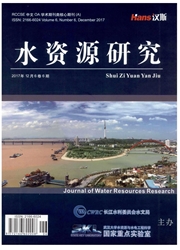

 中文摘要:
中文摘要:
在以降水补给为主的石羊河流域,探讨地表径流形成和径流量丰枯变化的大尺度水分背景具有重要意义。基于径流量、CRU降水量(TS3.24)和各时间尺度标准化降水蒸散指数(SPEI,CSIC v2.4)资料,利用Mann-Kendall趋势分析、小波分析及空间相关分析等方法,探讨出山径流量的演变特征及其与大尺度水分场的空间关联。结果表明:在20世纪后半段,出山径流量显著减少,在21世纪初,又呈现不同程度的增加趋势。在1962~1967、1970~1976、1991~2001年以偏枯为主,1956~1961、1976~1990、2002~2012年以偏丰为主。出山径流量具有显著的2-4a周期(1960s、1970s初),夏季和年径流量还具有显著的准4a周期(1980s末、1990s)。影响春季径流形成和丰枯变化的水分关键区在河西走廊中东部;影响秋季径流的关键区域在青藏高原东北缘和河西走廊东部,核心区位于100°E~105°E,33°N~41°N;影响夏季和年径流的关键区域在东亚夏季风北边缘,核心区位于100°E~110°E,33°N~42°N,呈东北–西南走向。
 英文摘要:
英文摘要:
In the Shiyang River basin, which is mainly supplied with precipitation, it is important to discuss the large- scale moisture background of surface runoff variation. Based on the runoff, CRU precipitation field (TS 3.24) and SPEI field (CSIC v2.4) on different time scales, the evolution characteristics of mountainous runoff and its spatial correlation with the large-scale moisture field were discussed utilizing Mann-Kendall trend analysis, wavelet analysis and spatial correlation analysis. The results show that in the second half of the 20th century, the mountainous runoff is significantly reduced, in the early 21st century, and show increasing trend at different significant levels. Annual mountainous runoff series contain the severe dry periods (during 1962-1967, 1970-1976 and 1991-2001) and three significant wet periods (1956-1961, 1976-1990 and 2002-2012) for nearly 60 years. The dominant periods of mountainous runoff calculated by wavelet analysis were 2 - 3 years (1960s and early 1970s), the dominant periods of summer and annual mountainous runoff were quasi-4 years (late 1980s and 1990s). The key areas of moisture field influencing spring mountainous runoff variation are in the middle and east of Hexi Corridor; the key areas affecting autumn mountainous runoff variation are the northeastern margin of the Qinghai-Tibet Plateau and the eastern part of the Hexi Corridor, with the core area at 100°E - 105°E and 33°N - 41°N; the key areas affecting summer and annual mountainous runoff variation are the northeastern part of the East Asian summer monsoon and the northeast-southwest direction of the core area at 100°E - 110°E and 33°N - 42°N.
 同期刊论文项目
同期刊论文项目
 同项目期刊论文
同项目期刊论文
 期刊信息
期刊信息
